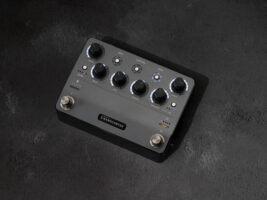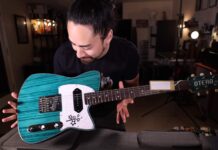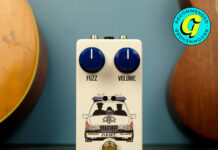
Multi-effects signal chains explained – everything you need to play and record direct
It wasn’t that long ago that home recording meant floors covered in effects pedals with a patchwork of cables leading from the bedroom into bathrooms and other nooks and crannies; turning our homes into impromptu recording studios and agonising over our cabinet mic placement.
That approach to home recording is by no means dead, but with the continued development of digital amp modellers and amp sim pedals, we no longer have to turn our homes upside down when we want to noodle and record with high-quality sounds.
While the digital package is more compact, it still comes with a learning curve. In this guide, I’m going to (hopefully) demystify the process of building a digital signal chain, highlighting the tools that are essential for playing and recording guitar at home.
What is a digital signal chain?
When we talk about ‘analogue’ guitar playing, the signal chain refers to the path your audio signal takes from guitar to amplifier and the effects it passes through along the way. There is no ‘right’ way to create a signal chain. My early ignorance on the subject created a Sigur Rós-esque distortion-soaked reverb effect that I adored, so it’s always worth experimenting.
When we talk about a digital signal chain, the principle is fundamentally the same, but rather than it being guitar > effects > amplifier it has multiple permutations such as:
Guitar > floorboard/rack amp modeller / amp sim pedal > mixer/interface > DAW
Guitar > floorboard/rack amp modeller > DAW
Guitar > mixer / interface > audio plugins > DAW
Guitar > amp sim / rehearsal pedal > FRFR cabinet/headphones
There are pros and cons to each of these permutations, not to mention varying cost implications and requirements for your home setup. In some cases, there’s no need for an audio interface/mixer but we’ll go into that later. Before we dive in, it’s important to establish the following:
What do you want to get out of your home setup?
Depending on where you’re at in your guitar journey and what drew you to the instrument will dictate what you need from a home setup. With that in mind, ask yourself these questions:
Is the purpose of your home setup to play/practise, record or both?
How much equipment do you have space for?
What is your budget?
Now that you’ve asked yourself those questions, let’s look at the individual elements that make up a digital signal chain for playing and recording guitar at home, starting with amp modellers.
Amp modellers and multi-effects units
Image: Adam Gasson
Here at Guitar.com, we’ve reviewed just about every major amp modeller out there. Back in 2021, the amp modeller that really changed the game, Neural DSP’s Quad Cortex, scored a 10/10 from us – and this was before Neural bolstered it with a series of QoL updates, new features and compact sequel. We’ve awarded similar glowing reviews to Kemper’s Profiler Stage, and in more recent years Fender’s Tone Master Pro and Boss’ GX-10.
Amp modellers are your one-stop shop and come equipped with countless digital amp sounds and effects, providing you with hundreds if not thousands of hours experimenting and refining your favourite tone combinations.
Thanks to USB connectivity, they can also function as your audio interface. This makes them an incredibly versatile addition to your home setup; providing you with everything you need to tinker, play, practise, rehearse, perform and record.
However, due to the serious punch these amp modellers pack, you could be looking at prices anywhere between £1,000 – £1,700 if buying brand new. In isolation it’s an eye-watering sum, but when you consider how far that budget would get you when buying amps, effects pedals and an interface; not to mention the amount of flexibility you’d have in tailoring your sound, the space required and the varying reliability of all those bits of equipment, it doesn’t take long before the value of the amp modellers starts to sink in.
It’s worth noting that a lot of these high-end amp modellers have released smaller and more budget-friendly iterations. Neural DSP’s Nano Cortex and Line6’s HX One are great examples of how to distill their predecessor’s DNA into a smaller and cheaper package. Speaking of smaller, cost-effective options, let’s turn our attention to amp sim pedals.
[products ids=”6ru2SrWqvzIT0ep6ZFcAXQ,4cDpuBQfkUhwXUrrSLYElh,B1FoUUSUyi3B2m1GQla65,2WuMky1iFUjk8qhee1PnNm,3Boy4LZm0Kqx95dawNB33c,4RbZPpF01Dh5uNrrEF9v77,6ADpQXMexHjV2MfjsPhuOS”]
Amp and cab sim pedals
Image: Adam Gasson
I don’t know about you, but when I look at something like Kemper’s Profiler Head, I can imagine the sheer quantity of sounds it can produce in that moment. The idea that even a fraction of that power could fit into a stompbox blows my mind, but it’s very much a reality.
In our review of the Walrus Audio Mako Series MKII ACS1, our reviewer said “this is as good as digital amp and cab simulators get”. While Walrus Audio has definitely carved out a niche for itself in terms of quality, they occupy the space with a suite of top-performing competitors. Whether its Universal Audio’s UAFX extensive series of amp and cab simulator pedals, the much-loved Strymon Iridium or the phenomenally good value Boss’ IR-2, there’s oodles of quality to suit a range of budgets.
With a severely reduced footprint and price tag, it should be no surprise that you won’t have quite the same level of tools at your fingertips, though the ACS1 is no slouch on amps to choose from!
That’s not to say you’ll be feeling short-changed as the amount of options under the hood is nothing short of amazing, but do your due diligence in researching what’s out there so you get the perfect fit for your needs.
Amp and cab sim pedals sit at the end of your signal chain, meaning your existing collection of effects pedals will work in perfect harmony and allow you to further tinker in search of that desired sound. The presence of a headphone out is ideal for anyone that can’t practise at full volume and/or isn’t hooking this up to their computer.
While we’re on the topic of hooking this up to computers, it’s worth mentioning that unlike the aforementioned digital amp modellers, these pedals require an audio interface if you’re looking to record while using them. If you’re thinking about relative budgets, unless you’re choosing the premium pedal(s) and audio interface, you’re unlikely to be spending more than the cheapest amp modeller.
[products ids=”5TxYvtVWAuwaawNgLLxEUk,7DvMk7LWI8xoOdCKku5DVE,5x9CmWUuj5rYUXyQdPwgMs,44by41VnpGe0Ly2nkjBzF9,7m74MWIg1x9sZa1pchR9Kn,21N5Q6yXC7vrVGa1stCyR6″]
Rehearsal pedals and FRFR amps
Image: Adam Gasson
This is just a bonus point, but you may have reached this point in the article hoping for something simpler and begun asking:
What do I do if I don’t want to run an amp sim pedal into my computer, but I also don’t want to practice over headphones?
Is there a way I can practice with my current pedalboard through headphones without needing an amp sim pedal or amplifier?
If space and portability are important to you, then Headrush’s FRFR Go is hard to beat when it comes to practising without headphones. There are some great alternatives out there like the Fender FR-12, but the FRFR Go leads the pack on price and portability by a mile.
If headphones are the goal, Walrus Audio’s Canvas Rehearsal eliminates the need for an amplifier or amp sim pedal and slots neatly into the end of your pedalboard. You can play your guitar with all your effects in headphones, practise your rhythm with the in-built metronome and time signature functions, and play along to your favourite songs over Bluetooth.
[products ids=”5iHPEBEaoeeOoyJLR7tMCo,6JmLBjNYj9NNAiAoK9JxAs,6SQwAUhdsz1TScKof82nol”]
Audio interfaces and mixers
If you’re just looking to play and practise, or even if you’re planning on getting an amp modeller that can double as an audio interface, it may not be necessary to add another item to the shopping list.
If however, you’re after more control on your audio, hoping to record using an amp sim pedal, or you want to record other instruments such as drums, that’s where an audio interface or mixer becomes an integral component of your digital signal chain.
On the simpler, more budget-friendly end of the scale you’ll find the Audient iD4 and Focusrite Scarlett 2i2 4th Gen interfaces; the latter now featuring stereo direct monitoring which is a big deal for those of you wanting to get the most from your stereo amp sims. What you lack in inputs, you gain in ease-of-use and price.
Universal Audio’s Apollo Twin X costs almost £800, but it boasts incredibly low latency for recording – which is invaluable when using amp sims – and comes bundled with some of UA’s stellar hardware plugin emulations, allowing for yet more sonic profiling.
There’s also the PreSonus Quantum HD 2, which can achieve around 3ms latency, comes kitted out with guitar-centric features developed with Fender amongst other pro features and costs 50% less than the Apollo Twin X.
Mixers start at a higher price point due to their increased number of inputs and greater functionality. That being said, Allen & Heath’s ZEDi 10FX, which comes in under £350 and sports some great sounding boutique preamps and the slightly more pricey but fully-featured Tascam Model 12 are well worth investigating if your home recording setup is likely to move beyond guitar alone.
[products ids=”69ARyGFpRDFet9DZNLaqIE,2wL4nkv5Vfp5IkhtS8PZZt,5ggaG7ANt6IHHHzd7QzZAW,3S1JY3asvsRVl5b06L5spq,”]
The post Multi-effects signal chains explained – everything you need to play and record direct appeared first on Guitar.com | All Things Guitar.
Source: www.guitar-bass.net













